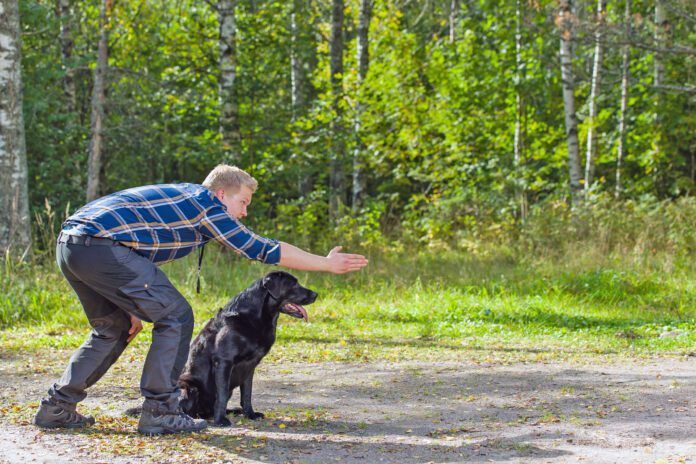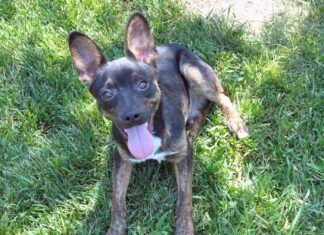Do you use hand signals to communicate with your dog? You should! When dogs know both hand signals and verbal cues, they are far more likely to respond to the hand signal than a verbal cue. A study published in Animal Cognition shows that “while dogs respond to both gestural and verbal requests, gestures are more salient than words.”
Yes, dogs are tuned in with body language, both of each other and of humans, so training hand signals is an important part of training. They can sense the intent of action from body language displayed by us and therefore understand us more clearly. Deaf dogs, of course, are dependent on those hand cues, and teaching them now can help if your dog loses hearing function as they age.
Dogs Read Body Language First
When I taught group classes, I would explain to my students that if they said one thing to their dogs with their voice and another thing with a hand signal, their dogs would be far more likely to respond to the hand signal than the verbal cue. I have always taught a hand signal for some things before I ever get to the verbal equivalent.
An example of that is teaching a sit or a down cue. My dogs have always learned the hand signal first. I eventually add a verbal cue, simply because I feel like I should but usually months later. What I personally use more frequently are hand signals.
If you’ve already taught basic cues using verbals like sit, wait, stay, and down, you can still add hand signals. Just start doing it. You will be surprised at how quickly your dog understands what you mean. If your starting your training from scratch, this article by noted trainer Kathy Callahan can help you get started, using hand signals first, then adding verbals.
Hand Signals to Teach Your Dog
Dogs learned to read our body language to determine our intent, especially movement and action. While you can use whatever hand signal is comfortable for you, examples of the hand signals that I teach my own dogs include:
- Sit: Fist made with thumb on top of closed fingers presented with knuckles facing the dog and fingers on the upside. You can teach it this way with a treat inside of your hand initially and the hand signal still looks the same sans treat inside. When actionable, it resembles a hand pulling a zipper up.
- Down: Fist made the same way as above but fingers/thumb facing down and knuckles facing up. Again, treat can be inside initially and easily relinquished with a proper down completed by simply opening the hand after flipping it up. This hand signal also looks the same sans treat.
- Touch: The usual way, flat palm, fingers tightly closed, palm up initially started literally right in front of the nose but underneath a bit to not look threatening.
- Chin Rest: Flat palm, fingers tightly closed, offered level under/near the chin but sideways positioned to the dog’s head, underneath the chin.
- Wait: Flat palm, fingers tightly closed, positioned with the fingers pointing to the sky with a brief push forward when initially offered.
- Paw: Mirror image hand offered palm up slightly cupped just in front of either front leg.
- By Me: Slightly extended arm with hand horizontally aligned, thumb up, with a waving motion in my direction aimed near my chest area. This is for a busier environment when on leash to keep my dog close.
- Can I Have That? (my name for Drop It): Palm up, fingers closed, positioned with fingers slightly cupped aimed towards the dog’s mouth just in front of such.
- Here Here (means come inside the house or come closer to me, period): Standing sideways to the dogs on my porch, using either arm extended while making a welcoming motion with my hand towards the door or myself.
- Stand: When the dog is seated, I use a flat palmed aimed down horizontally aligned hand positioned sideways to their nose and move the hand away from their nose to cue a stand.
- Spin: Primary finger pointing with thumb extended as well, other fingers closed, while making a circular spinning motion. One dog is a leftie, so his hand signal is reversed in position.
- All Done: Jazz hands to indicate we are done training for the moment, no more treats.
- Left and Right Turns: Pointing in the direction to go with arm extended. I used to hike, and trail run with multiple dogs on leash, so they were trained to look to me for which way we were heading when reaching a trail split. I am no longer that energetic but maybe you are?
I asked some fellow trainers which hand signals they use with their own dogs and was rewarded with these gems from Denise O’Moore, a trainer in Ireland:
- Distance Recall: Closed fist in the air.
- Go Play: Open hand.
- Come and Sit: Open hand to the side.
- Fast Distance Recall: Touching her bag means there is a toy so come at record speeds please.
Hand signals are a sign language for dogs. They are such a clearer communication method than verbal cues. There are so many things that can be more easily conveyed to dogs with hand signals and body language than with verbal cues. Dogs are experts in body language. Subtle differences in how you hold your hand when signaling to your dog what you want from them can make a huge difference. Being precise and consistent with your communication makes for less misunderstandings. Adding dog training hand signals to your repertoire with your dogs can only improve your mutual understanding so try it today.






